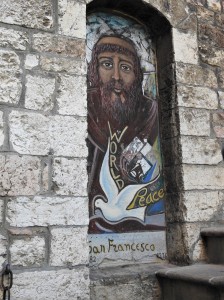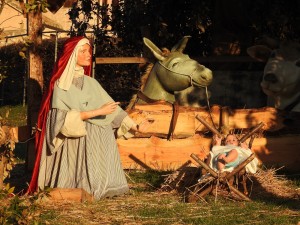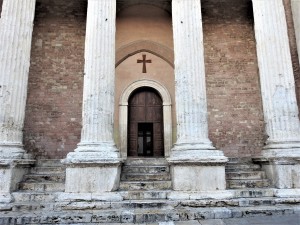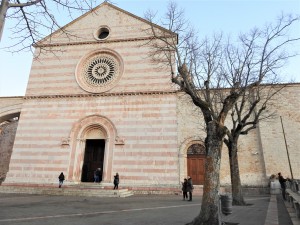-
AN UNEXPECTED VISIT
 Francis Bernardone came upon the abandoned church of San Damiano in Assisi by accident. He was searching for a place to meditate to find a way forward for his life, when he entered the church and saw a crucifix. As he prayed earnestly in front of it, he heard a voice telling him, “Francis, go and repair my church which, as you see, is all in ruins!” This brief moment changed not only the man’s life but even his birthplace, the Catholic Church, and the lives of many others. An unexpected visit to Assisi proved that the timeless appeal of this instant still prevails.
Francis Bernardone came upon the abandoned church of San Damiano in Assisi by accident. He was searching for a place to meditate to find a way forward for his life, when he entered the church and saw a crucifix. As he prayed earnestly in front of it, he heard a voice telling him, “Francis, go and repair my church which, as you see, is all in ruins!” This brief moment changed not only the man’s life but even his birthplace, the Catholic Church, and the lives of many others. An unexpected visit to Assisi proved that the timeless appeal of this instant still prevails.Dropping by at Assisi for a few hours while exploring the surrounding towns, I found myself getting absorbed in the spiritual atmosphere of this medieval location which has earned its place in the UNESCO list of World Heritage Sites for its influence on religious expression and Europe’s art history. Although it was anticipated that I would visit some churches, I was blown away by the monumental beauty of the basilicas, the medieval character of the town, the intriguing archaeological structures and the boundless feeling of serenity.
The Papal Basilica of St Francis of Assisi dominates the town. It constitutes two churches which are known as the lower and the upper churches. Whereas the lower church is austere and sombre, symbolising the humanity and humility of the saint, the upper church is high vaulted, airy, and widely illuminated to resemble his sanctity and glory. The arcades that line the open square as you approach the basilica were originally used to shelter and feed medieval pilgrims. Nowadays, these offer refuge from the natural elements to the numerous visitors who come to Assisi.
 According to legend, the area on which this basilica was built was originally considered disgraceful since it was a place for public execution. Francis chose it as his burial place because he considered himself as the worst sinner. Today, this blessed location which holds within it the venerated remains of the saint is renowned as the ‘Hill of Paradise’.
According to legend, the area on which this basilica was built was originally considered disgraceful since it was a place for public execution. Francis chose it as his burial place because he considered himself as the worst sinner. Today, this blessed location which holds within it the venerated remains of the saint is renowned as the ‘Hill of Paradise’.The interior of the basilica is an awesome masterpiece which bursts into your senses. Never have I seen such colourful splendour which reaches from top to bottom with frescoes done by leading artists of the 13th century, such as Cimabue, Giotto, Simone Martini, and Pietro Lorenzetti. In contrast, the cruciform crypt of St Francis located deep beneath the two-levelled basilica, is raw and simple. A large open pillar contains the roughly hewn stone sarcophagus which holds the blessed remains of the saint. In the four niches positioned at each angle facing the tomb lie the four disciples of St Francis: fra Leone, fra Masseo, fra Rufino and fra Angelo.
 Even though Christmas celebrations were long over, the Christmas spirit was still very present in Assisi. An exhibition of traditional cribs animated the silent corridors of the friary which is built adjacent to the basilica. Likewise, a large crib with numerous life-size figures gave life to the wide-open area in front of the upper church.
Even though Christmas celebrations were long over, the Christmas spirit was still very present in Assisi. An exhibition of traditional cribs animated the silent corridors of the friary which is built adjacent to the basilica. Likewise, a large crib with numerous life-size figures gave life to the wide-open area in front of the upper church.The main street named after St Francis leads from the basilica to the centre of the town. Like any pilgrimage site, Assisi has become highly commercialized, flooded with souvenir shops which sell all types and all sizes of mementos that depict the saint. Various hotels offer hospitality to the pilgrims and visitors who opt to relish this medieval town’s atmosphere for longer. The elegantly restored 13th century Santa Caterina Monastery, now known as Nun Assisi Relais & Spa Museum, has been turned into a minimalist-styled hotel, and is an unparalleled destination.
 The main square, Piazza del Comune, was always an important point in the town. This is evident by the presence of a Roman temple which is the focal point of the square. Built in the 1st century BC, the imposing temple was originally attributed to the goddess Minerva due to the finding of a female statue. However, recent archaeological discoveries in the area pertaining to other gods have created doubts about which god was honoured by this stately structure. The façade of the temple, with its six huge Corinthian columns supporting the architrave and a small pediment, has now been preserved. The pagan building which is also a UNESCO World Heritage Site serves as a bizarre entrance to the church which it now houses, Santa Maria sopra Minerva.
The main square, Piazza del Comune, was always an important point in the town. This is evident by the presence of a Roman temple which is the focal point of the square. Built in the 1st century BC, the imposing temple was originally attributed to the goddess Minerva due to the finding of a female statue. However, recent archaeological discoveries in the area pertaining to other gods have created doubts about which god was honoured by this stately structure. The façade of the temple, with its six huge Corinthian columns supporting the architrave and a small pediment, has now been preserved. The pagan building which is also a UNESCO World Heritage Site serves as a bizarre entrance to the church which it now houses, Santa Maria sopra Minerva.References to St Francis are present wherever you go in Assisi. Niches, wall paintings, and statues of his parents Pietro di Bernardone and Madonna Pica, continually remind you that this is the birthplace of the saint. Nevertheless, the curious visitor can still encounter offbeat locations such as art galleries, tartufo shops, and traditional cuisine.
 My visit ended at the Basilica of St Clare. Interestingly, the structure of its façade strongly imitates the upper church of the Basilica of St Francis, just how St Clare followed St Francis. Although far from the exuberant quality which one finds in the Basilica of St Francis, this church is still beautifully adorned. The ceiling of the chamber which houses the tomb of St Clare is pleasantly decorated with a blue sky filled with shining stars.
My visit ended at the Basilica of St Clare. Interestingly, the structure of its façade strongly imitates the upper church of the Basilica of St Francis, just how St Clare followed St Francis. Although far from the exuberant quality which one finds in the Basilica of St Francis, this church is still beautifully adorned. The ceiling of the chamber which houses the tomb of St Clare is pleasantly decorated with a blue sky filled with shining stars.The humbler nature of this basilica does not diminish its respect or importance. The Crucifix Chapel located inside protects within it the Byzantine cross which was originally at the ruined church of San Damiano. On the other hand, the Chapel of the Blessed Sacrament occupies the area of the ancient Church of St George, in which both St Francis and St Clare were buried until their basilicas were constructed.
A splendid sunset welcomed me as I stepped out in the square of the Basilica of St Clare from where I could enjoy a fantastic view of the surrounding area. Rocca Maggiore castle hovered over the town and bid me to visit, while at a distance, the Renaissance Basilica of St Mary of the Angels which houses the Porziuncola, the most sacred place for the Franciscans, reminded me that there was so much more to discover.
(This feature was published in the SENIOR TIMES issued with The Times of Malta dated 15th February 2019)
Category: Times of Malta | Tags: art,Assisi,basilica,Basilica of St Clare,Basilica of St Mary of the Angels,Byzantine cross,Chapel of the Blessed Sacrament,church,Church of St George,Cimabue,Crucifix Chapel,crypt,Fiona Vella,fra Angelo,fra Leone,fra Masseo,fra Rufino,Francis Bernardone,Franciscans,Giotto,Hill of Paradise,history,Madonna Pica,Minerva,Nun Assisi Relais & Spa Museum,papal basilica,Papal Basilica of St Francis of Assisi,Piazza del Comune,Pietro di Bernardone,Pietro Lorenzetti,Porziuncola,religion,Rocca Maggiore,San Damiano,Simone Martini,St Clare,St Francis,UNESCO